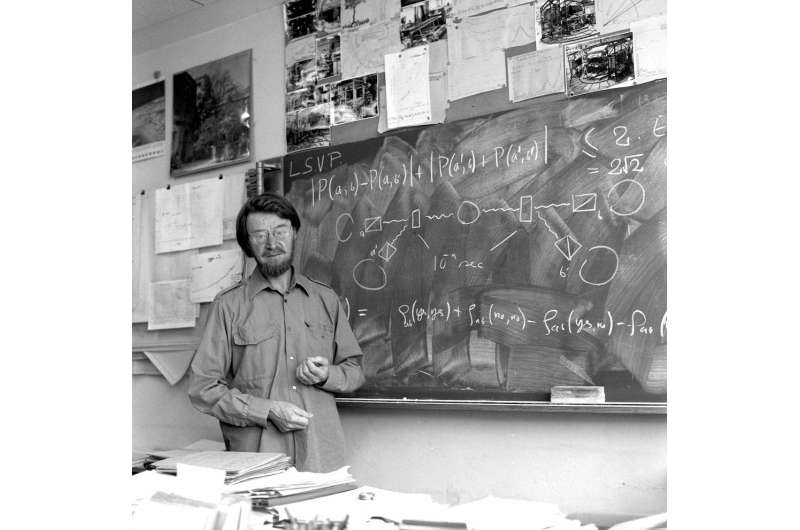Stav Dimitropoulos
Sat, July 9, 2022

Photo credit: VICTOR de SCHWANBERG/SCIENCE PHOTO LIBRARY - Getty Images
One of the biggest mysteries in quantum mechanics is whether physical reality exists independent of its observer.
New research from Brazil provides strong evidence that there might be mutually exclusive, yet complementary physical realities in the quantum realm.
Future research on the great quantum debate might give us super-disruptive quantum technologies—and probably startling answers to the world’s greatest mysteries.
Does reality exist, or does it take shape when an observer measures it? Akin to the age-old conundrum of whether a tree makes a sound if it falls in a forest with no one around to hear it, the above question remains one of the most tantalizing in the field of quantum mechanics, the branch of science dealing with the behavior of subatomic particles on the microscopic level.
In a field where intriguing, almost mysterious phenomena like “quantum superposition” prevail—a situation where one particle can be in two or even “all” possible places at the same time—some experts say reality exists outside of your own awareness, and there’s nothing you can do to change it. Others insist “quantum reality” might be some form of Play-Doh you mold into different shapes with your own actions. Now, scientists from the Federal University of ABC (UFABC) in the São Paulo metropolitan area in Brazil are adding fuel to the suggestion that reality might be “in the eye of the observer.”
In their new research, published in the journal Communications Physics in April, the scientists in Brazil attempted to verify the “complementarity principle” the famous Danish physicist Niels Bohr proposed in 1928. It states that objects come with certain pairs of complementary properties, which are impossible to observe or measure at the same time, like energy and duration, or position and momentum. For example, no matter how you set up an experiment involving a pair of electrons, there’s no way you can study the position of both quantities at the same time: the test will illustrate the position of the first electron, but obscure the position of the second particle (the complementary particle) at the same time.
“God Does Not Play Dice”
To understand how this complementarity principle relates to objective reality, we need to dive back into history, about a century ago. A legendary debate took place in Brussels in 1927 between Bohr and the celebrated German-born theoretical physicist Albert Einstein during the fifth Solvay Conference (the most important annual international conference in physics and chemistry).

Photo credit: Science & Society Picture Library - Getty Images
Before the eyes of 77 other brilliant scientists, who had all gathered in the Austrian capital to discuss the nascent field of quantum theory, Einstein insisted that quantum states had their own reality independent of how a scientist acted upon them. Bohr, meanwhile, defended the idea that quantum systems can only have their own reality defined after the scientist has set up the experimental design.
“God does not play dice,” Einstein said.
“A system behaves as a wave or a particle depending on context, but you cannot predict which it will do,” argued Bohr, pointing to the concept of wave-particle duality, which says that matter may appear as a wave in one moment, and appear as a particle in another moment, an idea that French physicist Louis de Broglie first put forth in 1924.
The “Complementarity Principle”
It didn’t take long after the conclusion of the 1927 Solvay Conference for Bohr to publicly articulate his complementarity principle. Over the next few decades, the controversial Bohr notion would be tested and retested to the bone. One of those that experimented with the complementarity principle was American theoretical physicist John Archibald Wheeler.
Wheeler attempted to reimagine Thomas Young’s 1801 double-slit experiment into the properties of light in 1978. The two-slit experiment involves shining a light on a wall with two parallel slits. As the light passes through each slit, on the far side of the divider, it diffracts and overlaps with the light from the other slit, interfering with one another. That means no more straight lines: the graph pattern that emerges at the end of the experiment is an interference pattern, which means that the light is moving in waves. Essentially, light has both a particle and a wave nature, and these two natures are inseparable.
Wheeler had his device switch between a “wave-measuring apparatus” and a “particle-measuring apparatus” after the light had already traveled through most of the machine. In other words, he made a delayed choice between whether the light had already propagated as a wave or a particle, and found that even after delaying the choice, the principle of complementarity was not violated.
However, more recent surveys, which attempted to apply the quantum superposition principle on the delayed-choice experiment, saw the two possibilities coexist (just as two waves on the surface of a lake can overlap). This suggested a hybrid wave-like and particle-like behavior within the same apparatus, contradicting the complementarity principle.
Quantum-Controlled Reality
The Brazilian scientists decided to also design a quantum-controlled reality experiment.
“We used nuclear magnetic resonance techniques similar to those used in medical imaging,” Roberto M. Serra, a quantum information science and technology researcher at UFABC, who led the experiment, tells Popular Mechanics. Particles like protons, neutrons, and electrons all have a nuclear spin, which is a magnetic property analogous to the orientation of a needle in a compass. “We manipulated these nuclear spins of different atoms in a molecule employing a type of electromagnetic radiation. In this setup, we created a new interference device for a proton nuclear spin to investigate its wave and particle reality in the quantum realm,” Serra explains.
“This new arrangement produced exactly the same observed statistics as previous quantum delayed-choice experiments,” Pedro Ruas Dieguez, now a postdoctoral research fellow at the International Centre for Theory of Quantum Technologies (ICTQT) in Poland, who was part of the study, tells Popular Mechanics. “However, in the new configuration, we were able to connect the result of the experiment with the way waves and particles behave in a way that verifies Bohr’s complementarity principle,” Dieguez continues.
The main takeaway from the April 2022 study is that physical reality in the quantum world is made of mutually exclusive entities that, nonetheless, do not contradict but complete each other.
This is a fascinating result, experts say. “The Brazilian researchers have devised a mathematical framework and corresponding experimental configuration that allows the testing of quantum theory, particularly understanding the nature of complementarity by studying the physical realism of the system,” Stephen Holler, an associate professor of physics at Fordham University, tells Popular Mechanics.
It is a study that highlights the long-standing adage of the iconic American quantum physicist and Nobel laureate Richard Feynman: “If you think you understand quantum mechanics, you don’t understand quantum mechanics,” says Holler. “There’s much to learn about the theory and researchers continue to make strides to understand even basic principles, which is especially important as we move into the age where quantum devices and computing are starting to proliferate.”
Dieguez is elated. “The fact that a material particle may behave like a wave and light like a particle, depending on the context, is still one of the most intriguing and beautiful mysteries of quantum physics,” he says.
Paradoxically, this inherent “weirdness” of quantum mechanics can prove quite serviceable: “The more we unravel quantum mechanics, the more we are able to provide disruptive quantum technologies outshining their classical counterparts, quantum computers, quantum cryptography, quantum sensors, and quantum thermal devices included,” says Serra.
That reality might be in the eye of the observer is a very peculiar aspect of the physical reality in the quantum domain, and the mystery itself shows no signs of abating, both researchers agree.






